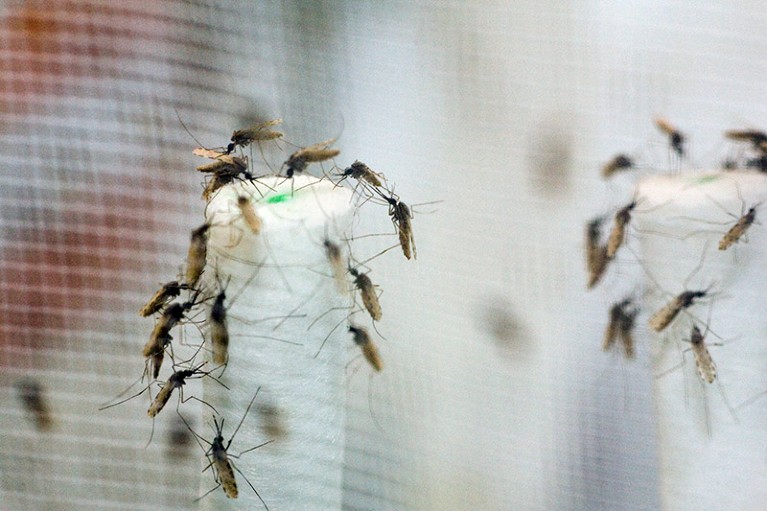
Malaria is caused by the Plasmodium parasite, carried by female Anopheles mosquitoes.Credit: Cecile Degremont/Look at Sciences/SPL
Malaria is likely to kill more than 600,000 people this year. Nearly four out of five will be children under five years old, mostly in Africa. One child dies of the disease every minute, says Michael Charles, chief executive of the global RBM Partnership to End Malaria. The disease is one of the largest causes of child mortality.
Last week saw reason for hope. Scientific advisers to the World Health Organization (WHO) recommended a second malaria vaccine, after decades of development. It is called R21 and has been developed by researchers at the University of Oxford, UK, and the Serum Institute of India in Pune. It uses technology from US biotechnology company Novavax and was funded by European Union institutions and by Wellcome, a biomedical research funder in London. R21 follows RTS,S (or Mosquirix), the world’s first malaria vaccine — developed by the pharmaceutical company GSK with support from the Bill and Melinda Gates Foundation in Seattle, Washington, and others — which in 2021 received WHO endorsement for broad use in children.
Second malaria vaccine to win global approval is cheaper and easier to make
After additional WHO approvals, the vaccine could be ready for use by the middle of next year. But without step changes in planning, funding and local vaccine manufacturing, progress towards reducing the disease’s toll will be too slow.
The third of the United Nations Sustainable Development Goals includes a target to eliminate malaria. The COVID-19 pandemic reversed gradual, but discernible, progress in this respect. Worldwide, malaria deaths fell from 897,000 in 2000 to 568,000 in 2019. But they increased to 625,000 in 2020, and indications are that they have stayed at similar levels since.
Vaccines have been slow to come, principally because of the complex life cycle of the parasite Plasmodium. Five species of this parasite cause malaria in humans, and two, P. falciparum and P. vivax, pose the biggest risk. When an infected mosquito bites someone, the parasite is transmitted to their bloodstream. It enters the liver, where it multiplies, mostly without causing symptoms, and then invades red blood cells, leading to characteristic symptoms such as fever and chills.
Malaria vaccines target the early stages of the Plasmodium life cycle. R21 acts on a protein on the infective parasite’s surface, stopping it entering liver cells. It showed 75% efficacy in phase III clinical trials in 4,800 children in Burkina Faso, Kenya, Mali and Tanzania, countries with high seasonal rates of malaria transmission (M. S. Datoo et al. Preprint at SSRN http://doi.org/kxwc; 2023).
RTS,S is similar in some ways. Both vaccines are given to children in three doses, followed by a booster, and they use the same immune-system-stimulating antigen. But RTS,S is configured differently and contains a different adjuvant, a protein designed to enhance the immune response generated by the vaccine.
So far, RTS,S has been administered to more than 1.7 million children across Ghana, Kenya and Malawi. A further 18 million doses will be sent to 12 African countries by 2026. The WHO estimates that 40 million to 60 million malaria-vaccine doses will be needed annually by 2026. Demand is expected to grow to between 80 million and 100 million doses each year by 2030. The Serum Institute currently has the capacity to make 100 million doses of R21 each year, and this is expected to double to 200 million by 2025.
Malaria vaccine booster prolongs protection
This is undoubtedly positive, but questions remain over funding. Malaria programmes are already short by around US$1.5 billion annually to meet their existing targets. This deficit is set to increase to $3.8 billion by 2026. It’s one thing to have the capacity to design and make vaccines, but another to find the money to fund them.
And vaccine manufacturing capacity must be ramped up in Africa. As was laid bare during the pandemic, the continent’s 54 countries import 99% of their vaccines. The poorest countries must wait for donations to pay for doses and depend on other nations to manufacture vaccines. That is not how an endemic disease is ended. Experience shows, too, that when there is a global health emergency, countries that export vaccines will prioritize their own populations before releasing supplies to others.
Since the pandemic, African Union member states have been ramping up their vaccine manufacturing capacity. A report announced last week by the Africa Centres for Disease Control and Prevention, based in Addis Ababa, and the Clinton Health Access Initiative in New York City, says that local manufacturers now have enough capacity to ‘fill and finish’ 2 billion doses of all vaccines annually, far in excess of the 1.3 billion needed each year on the continent (see go.nature.com/3pn7u). But they still lack the capacity to produce antigens, and there are few agreements with pharmaceutical companies to tackle this problem.
Last week’s development is a significant step: it offers a path to fewer deaths among very young children. As Charles told Nature, “These are not just figures. They are lives.” But vaccine approval must be accompanied by a comprehensive funding and eradication plan.
This will require money for vaccine manufacturing, plus programmes to increase the availability of clean water, good sanitation, insecticide-treated bednets and other preventive measures. Only with all these in place can the world say it is doing everything it can to capitalize on scientific advances and reduce malaria’s death toll — especially among children.

 Second malaria vaccine to win global approval is cheaper and easier to make
Second malaria vaccine to win global approval is cheaper and easier to make
 Malaria vaccine booster prolongs protection
Malaria vaccine booster prolongs protection
 How COVID spurred Africa to plot a vaccines revolution
How COVID spurred Africa to plot a vaccines revolution
 Africa’s vaccines revolution must have research at its core
Africa’s vaccines revolution must have research at its core
 Africa is bringing vaccine manufacturing home
Africa is bringing vaccine manufacturing home








